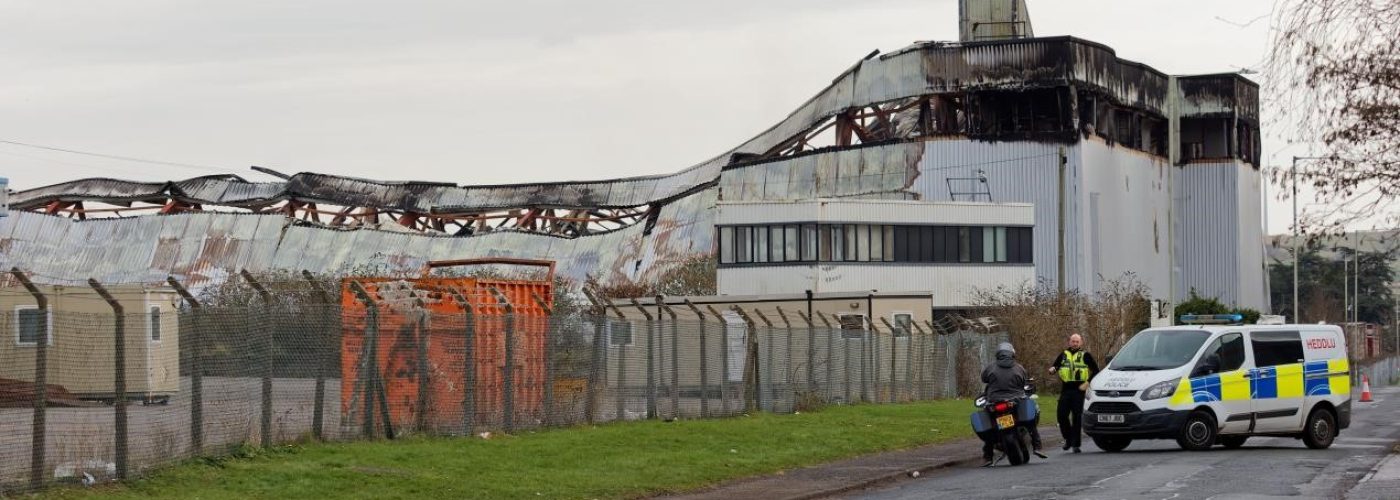A major fire at an industrial estate in Bridgend destroyed a huge 20,000m2 building used largely for warehousing, sending plumes of smoke into the surrounding area. One of the largest fires in Europe in recent times, the scale of the blaze was immense, impacting a number of businesses and highlighting gaps in fire safety measures.
The devastating fire broke out on January 19th in a building largely housing a warehouse owned by the Owens Group. This was also home to a number of businesses ranging from a tyre company and storage facility to a company selling paper products, the building was completely destroyed. The blaze required 10 fire crews, four water carriers and two aerial ladder platforms from the South Wales Fire and Rescue Service who worked hard to contain it. Local residents had to contend with large plumes of smoke shortly after the fire broke out and there were also reports of explosions. Police have since opened an arson investigation.
Thankfully, there were no reported injuries in the blaze but there will be repercussions for businesses within the warehouse, as well as adjacent businesses close to the main warehouse who lost access and power to their premises. There will also be disruption to all the other businesses that used the services of the affected companies. A training facility and a satellite operation of Bridgend College were also closed because of their proximity to the blaze. The impact on the local community and environment was significant with local road closures and nearby residents forced to close windows and doors.
This former Sony factory was reportedly sold off in 2005 when the company ceased manufacturing televisions in Wales. It was then bought by a developer who turned it into units of varying sizes. There was no original change of use as it retained B1/B8 classification (i.e conceived as a factory/warehouse). It’s important to point out that unless the whole building was storage, automatic sprinklers would not have been required from a Building Regulations perspective. However, any partitions erected within the building to separate units and changing uses within the building were ineffective. It points to the fact that for such buildings the unit of control is the entire building and not a smaller compartment within it.
The stark contrast between buildings equipped with sprinkler systems and those without becomes evident in the event of a fire. Recent statistics reveal the average cost of a large warehouse fire amounts to £5.9m1 and at least one warehouse fire occurring every working day in England alone. These figures underscore the critical importance for businesses to carefully consider the impact of fire and its devastating consequences.
Quickly stopping the spread of fire when it is first detected is the best way to limit damage and minimise costs and impacts. Sprinklers have been shown to contain, control or extinguish fires in 99% of cases when caused to operate2. The affected business can be operational within hours, avoiding the economic and social costs. Fire incidents remain the primary cause of damage in warehouse buildings, and although the number of industrial fires may have decreased, the severity and cost of such incidents that do occur are on the rise. Implementing systems like sprinklers can effectively contain and extinguish fires, thereby safeguarding firefighters and preserving businesses, jobs, and the economy. This is why the Business Sprinkler Alliance campaigns for the inclusion of such sprinkler systems into warehousing units.
Building, Design & Construction Magazine | The Choice of Industry Professionals
1Fears pandemic-led e-commerce boom could spark rise in warehouse blazes
2Efficiency and Effectiveness of Sprinkler Systems in the United Kingdom: An Analysis from Fire Service Data – Optimal Economics May 2017





